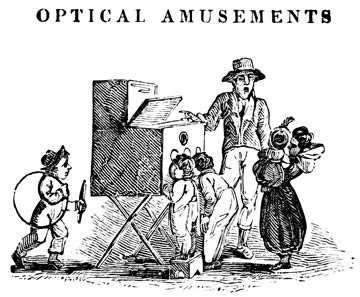
|
| No, that is NOT a camera obscura! |
We spend a great deal of time looking for examples and information on camera obscuras. From time to time we see objects or buildings identified as camera obscuras that we know, or suspect, are not. We have even purchased images described as camera obscura related that, after investigation, appear to be other kinds of objects/buildings. This page will discuss some examples that are most often misidentified as camera obscuras. |
|||||
| -No, it's not a Camera Obscura, it's a Peepshow. | |||||
The most commonly misidentified object is the peepshow or viewbox. Many of them look very much like a box camera obscura and to further complicate the matter there are some boxes that can be either one depending on the way they are configured. Let us first deal with the differences in a simple camera obscura and peepshow box. The purpose of the camera obscura is to project the entire outside world into a dark "box" which can be small enough to hold in your hand or as big as a building. The purpose of the peepshow box is to contain a small world inside it and let you peep in from the outside to see it. It is a box version of the sugar Easter egg from out childhood that contained small pictures and sugar objects like flowers with a hole at one end to view the wonderful little world inside. In a way the camera obscura works from the outside in and the peepshow from the inside out. Our site "A Collection of Collections" which features a number of our collections, includes several pages on our peepshows. |
|||||
 |
On the left is an illustration from a 19th century children's book showing a peepshow or raree show (probably derived from the term "rare show") with children lining up to peer into the openings. Because they are boxes with a lens or opening they are often mislabeled as camera obscuras. The boxes contained one or more colored pictures which were often pierced and made transparent in areas so that they changed as the light entering the box was manipulated by opening and closing doors. Some examples of this effect can be seen on a page of our peepshow views. |
||||
|
|||||
 |
On the left is an illustration from The Gentleman's Magazine, April 1753. It describes the apparatus shown as a combination view box and camera obscura. When a picture is placed in the AB position it can be viewed through the lens but when the picture is removed the lens will project an image of the outside into the back of the box. We have also seen examples of more elaborate 18th century instruments that can be converted from peepshows to camera obscuras. |
||||
| -No, it's not a Camera Obscura, it's a Camera Lucida. | |||||
|
|||||
| -No, it's not a Camera Obscura, it's just a small building. | |||||
We actively seek photographs of camera obscuras at the seaside, in parks, and and other scenic locations. In the 19th and early 20th century they were very common in any place where the view was interesting and people gathered. Sometimes there are references to their location where we have never found them pictured or there are photographs or drawings in places where we have not found any written reference. We actively collect artifacts and references in an attempt to put together as much information as we can. Any small building in a photograph or drawings causes us to look more closely. We have found camera obscuras that are not identified as such, some that are clearly not, but others where it is difficult to tell. On the right is an example of a stereo card we bought on speculation. It was described as a card with a "camera obscura?" in New York's Central Park. As can be seen in the close up below right it does look very much like a camera obscura. It looks different from the stereo card in our collection that shows a camera obscura on a raised platform in the park but is very like a drawing we have on a trade card. See our page on Lost US Park Camera Obscuras on this site. After buying the card we found a stereo of the lake from a different viewpoint that shows a small building with windows. We will continue our research but now think it might be a ticket office. |
|
||||